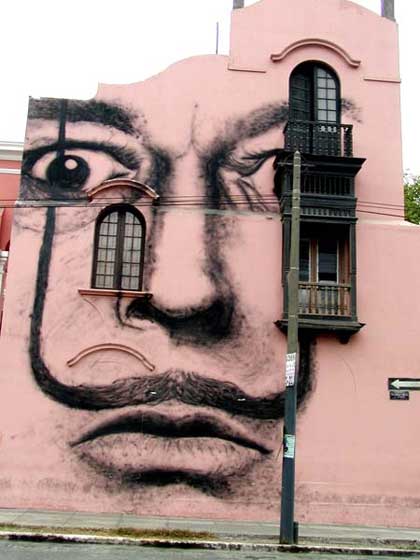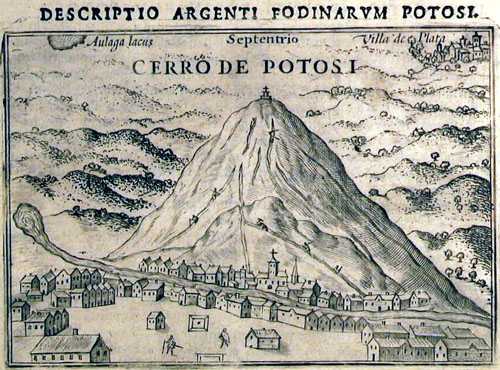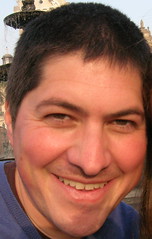3.28.2005
Dalí en Lima

Patrick Barry Barr has been taking photos of graffiti and murals in various cities including Milan, Barcelona, Bilbao, BeloHorizonte (Brasil), Lima and, Queens, NYC. The photo above was a mural he found in Lima, where he now lives. You can see his photos on Flickr. Or read his blog, Ruminations and Pictures.
3.26.2005
World's tallest waterfall

Angel Falls is located in the Guayana highlands of Venezuela. It plunges off the edge of a "tepui", or table-top mountain, and free falls 2,421 feet to the river below, making it the tallest waterfall on earth. In fact, Angel Falls is 15 times higher than Niagara Falls. It does, however, suffer from a lack of good gift shops.
The falls are named after Jimmy Angel, a barnstorming bush pilot from Missouri who first saw the falls in 1933 while searching for ore. He returned in 1937 and landed on top of the tepui. His Falamingo monoplane settled down into the marshy ground atop Auyan-tepui and remained there for 33 years before being lifted out by a helicopter. Jimmy Angel and his three comapnions managed to descend the tepui and make their way back to civilization. It took them 11 days.
3.25.2005
O Cravinho

Cachaça is to Brazil what rum is to the Caribbean. It's the national distilled spirit.
In the Pelourinho of Bahia, O Cravinho (literally, "The Little Clove") is a restaurant/bar owned and run by Julival Santos Reis, a gentle man with the manner and appearance of a field biologist.
At O Cravinho, cachaça is taken as seriously as a wine in France, beer in Germany or tequila in Mexico. Sr. Reis will gladly and knowledgeably discuss (in Portuguese) the various distilling methods and types of wood used in barrels for aging cachaça.
Find out more about Pelourinho and other Bahian attractions at Bahia Online.
3.23.2005
And we can't elect a woman because...?

Why is it that other countries, often with more conservative cultures, seem able to cope with the concept of having a woman as president or PM? Heck, even Pakistan has had a women in high office. I'm sure it wouldn't solve all the world's ills, but we don't seem to be getting anywhere with the pasty-white Ivy League guys running things.
Above: Soledad Alvear (left) and Michelle Bachelet (right) are former cabinet officials who are seeking the nomination from the center-left government coalition for the Dec.12 presidential election in Chile. Polls show that either candidate would be likely to beat a candidate from the right-wing opposition. Read the full article.
3.17.2005
Paraiso em Brasil

This view can be yours for a mere US$430,000. This five-bedroom house, with a pool and six-car garage is situated on a mountain overlooking the sea -- all a 15-minute drive from downtown Angra and 150 kilometers from Rio de Janeiro. There's even space for a street-level restaurant. I wonder what kind of American food would sell in Brazil? Minnesota Hot Dish, perhaps?
Galería de cocina peruana: Ceviche

Sea bass (corvina), marinated with bermuda onions, garlic and ají (chile pepper) in key lime (límon ácido) juice. Admittedly, it's an aquired taste for a landlubbing gringo, but once you're hooked...
Photo by Reinhard Kirsch
Um, whatever.

I thought it best that you heard the tragic news from a friend. Debbie and Bianca have been eliminated from The Amazing Race.
Bringing good things to light

A Bolivian family basks in the glow of its solar-powered LED lamp.
Anthony and Faith Harckham of Calgary, Alberta, have have made it their mission to free remote communities from reliance on costly kerosene lighting, which . Their solution: LEDs, which convert electricity into light relatively efficiently, powered by photovoltaic cells, which can reliably generate the necessary electricity from abundant sunlight.
Luxtreks, their nonprofit venture, has put these lamps in the homes of more than 700 impoverished families in Bolivia, Peru, Nepal and Pakistan by enlisting the help of travelers. Do-gooders who sign up with Luxtreks pay $750 above their travel costs, which covers the cost of lighting about 20 homes. They then head out to the destination country and actually help to install the lights, seeing beautiful scenery and meeting terriffic people along the way.
Perhaps not coincidentally, Light the World, a nonprofit with a similar cause is also headquartered in Calgary.
Read the full story in IEEE Spectrum.
3.16.2005
You say "xitomatl"...

A plant which is a fruit, technically—it’s a berry—the tomato springs from a wild viney plant which originally grew all over the high Andes region of Peru and Bolivia, along with its kissing cousin, the potato. Probably plucked and eaten on the spot by the locals but not cultivated, the tiny fruit was highly perishable and its growing season short.
Someone, perhaps the birds, brought the tomato north to what is now Mexico where the fruit was named "xitomatl." The Aztecs and other speakers of Nahuatl, native peoples of Central America and Mexico did indeed cultivate the tomato.
Carried to Europe by the Spanish, the tomato first seen by and noted by an Italian herbalist in the 1540’s was small, pear-shaped and yellow in color. The Italian word "pomo d’oro" or golden apple thus makes sense. The Italians were the first Europeans to make the fruit their own, breeding and cultivating it with gusto. The results, of course, are well known. A tradition less than 400 years old, Italian cooking without the tomato is unthinkable.
From the Tomato exhibit at the Food Museum Online.
3.15.2005
Digging yucca with the locals

"Twenty years after I’d last set foot in San Juan de Tela, a palm-shaded village on the north coast of Honduras, I ran into a man who said he remembered me. He proved it with a question: Didn’t you go with Doña Matilda one morning and dig yucca? Yes, I said, stunned. One of the village women had let me help her dig the roots that are a local staple. The man had been a little boy then, but he remembered because that was something tourists never did. There’s a moral here: Get involved in the places you go. And travel sensitively — you never know whose memories you’ll end up in."
So observed Catherine Watson, former Travel Editor for the Minneapolis Star Tribune, reflecting on her favorite destinations from her 26 years of writing for the paper.
Photo by Catherine Watson.
3.12.2005
Cities on volcanoes

The Andean region of Ecuador is a volcanologist's paradise and a risk manager's nightmare. Along the densely populated Interandean Valley, there are approximately 30 potentially active volcanoes, eight of which have erupted during the last 500 years. Guagua Pichincha (above), shown blowing off steam in 1999, lies only a few short miles from the capital of Quito, population 1.2 million.
Cities on Volcanoes 4 is a symposium that will meet in Quito next year to help city officials, emergency managers and volcanologists figure out how to avoid future volcanic disasters. The fun part? Dozens of field trips onto and into nearby volcanoes.
3.08.2005

Quito, Ecuador, as seen from inside the statue of the Virgen de Quito, atop the hill known as El Panecillo. Photo by Don Ball.
3.06.2005
I am rich Potosí, the mountain that eats men.


The magnificent mountain of Potosí in Bolivia yielded more silver than any other mountain or region of the world. In the 16th and 17th centuries this wealth flowed through Spain into Europe and played an important role in the beginnings of the Industrial Revolution and trade with Asia. Yet the grueling work of extracting the silver was left to the indigenous population of the Andes, who were enslaved by the Spanish and died by the thousands on the mountain.
Today, Potosí maintains this unique culture, based on its epic history. Approximately 18,000 miners still work in or around the mountain, searching for trace amounts of silver and tin. Inside the mountain, miners worship their devil, who is represented as a sexually potent Spaniard, lord of the mineral realm.
Photographer Stephen Ferry has made many trips to Potosí to document this ongoing drama. His book, I Am Rich Potosi. The Mountain That Eats Men, describes this world in color images. You can also see his online Potosí photo journal.
3.03.2005
Che lives on in Bolivia

"Amazing how Che Guevara lives on! This old gentleman wanted his picture taken next to the painting in the village of Tiwanaku, just a little way from where the ruins of La Puerta del Sol (Door of the Sun) are located."
Photo and commentary by Mike Sweeney. See more of his Bolivia photos.
Heifers in Honduras



"Before you can qualify to receive an animal from Heifer Project International, you have to attend animal husbandry classes and construct an approved shelter for the animal. Herman Molina built a house for his cow that was better than the house where he was living, so he moved in with his cow! In keeping with the zero grazing policy of HPI, Herman cuts fodder and brings it to his cow. He says that the cow is housebroken and always asks to go out. Herman's cow is pregnant and when the calf is delivered, Herman will give it to another qualified villager in a ceremony that HPI calls "passing the gift." It was sunset when I walked up the hill to his house and the photos in the house are made with the Noctilux, wide open."
Photos and commentary by Tina Manley. See more of her photos of Herman Molina.
3.02.2005
Ni chicha, ni limonada

In the Andes, chicha is the beverage of champions. It's basically corn beer. The flavor? Slightly sweet and somewhat moldy. It's usually made thorugh open fermentation (letting the natural yeasts do their work).
Occasionally, other bugs find their way into the brew, including nasty bacteria. This wouldn't stop me from drinking the stuff. But a dear Colombian friend told me that you can't get chicha in his country, at least not legally, because of a debilitating disease called "chichsimo," which was discovered in the last century.
In a rare show of consumer protectionism (certainly pre-dating what remaining consumer protections we take for granted here in the U.S.), the Colombian government actually outlawed chicha. Naturally, the family that controlled the flow of chicha was given the beer concession and overnight the chicherias were turned into beer houses.
Port-a-potty a la peruana

I guess it's true that if the government refuses to provide services, eventually the private sector will kick in. No suprise then, that a really nifty portable toilet (only 3 kilos) has been developed in Peru, the land of abysmal public facilities. Order yours today.
Ancient earth drawings found in Peru

LIMA, Peru (Feb. 28) - Archaeologists have discovered a group of giant figures scraped into the hills of Peru's southern coastal desert that are believed to predate the country's famed Nazca lines.
About 50 figures were etched into the earth over an area roughly 90 square miles near the city of Palpa, 220 miles southeast of Lima, El Comercio newspaper reported.
The drawings - which include human figures as well as animals such as birds, monkeys, and felines - are believed to be created by members of the Paracas culture sometime between 600 and 100 B.C., Johny Islas, the director of the Andean Institute of Archaeological Studies, told the newspaper.
One prominent figure appears to represent a deity commonly depicted on textiles and ceramics from the period, Islas said.
The recently discovered designs predate the country's famous Nazca lines, which have mystified scientists and were added to the United Nation's Cultural Heritage list in 1994.
The Nazca lines - which also include pictographs of various animals - cover a 35-mile stretch of desert some 250 miles south of Lima and are one of Peru's top tourist attractions. The Nazca culture flourished between 50 B.C. and 600 A.D., Islas said.
The lines, thousands of them in all, were made by clearing darker rocks on the desert surface to expose lighter soil underneath.




